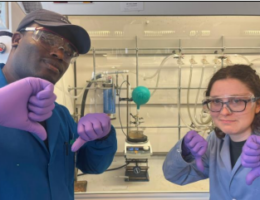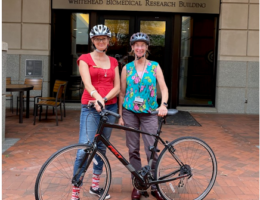Green Labs Highlights
As a nationally recognized leader in science education, Emory University has hundreds of teaching and research labs spread across multiple campuses.
Emory’s Green Labs program establishes our reputation as a leader in managing our operations sustainably while providing the high-quality educational experiences to students, world-class research and exemplary patient care.
Many labs use animals for research; by 2025, at least 95 percent of non-hazardous animal bedding will be composted.
How it Works
Step 1: Learn what sustainable actions your lab can adopt, and tell us what you’re already doing, by filling out the Green Labs at Emory Form through OSI Online Forms and consulting the companion Green Labs Guidance Document.
Step 2: Take Action by submitting the form and receiving a certification level. Detailed instructions are on the form.
Step 3: Earn Recognition for taking action to make more sustainable choices in your lab. The Green Labs at Emory Team will review your checklist and award your lab with a certification level. You will receive recognition and visible lab signage and graphics.
Step 4: Apply for funding to implement the actions on your checklist and new innovations by submitting a Green Labs Incentives Fund Application. The 2024-2025 Incentives Fund applications are CLOSED. Check here or subscribe to our newsletter to learn when they reopen.
Click here to check out the past year’s winners.
Learn about more ways to receive funding through OSI.
Lab Freezer Challenge
Thousands of scientists around the world compete in the International Laboratory Freezer Challenge each year to learn how to be more energy efficient with their lab’s cold storage, improve sample accessibility, reduce risk, and save costs for their institutions. Second only to fume hoods, your lab’s cold storage (refrigerators, freezers, cold rooms) is likely the next biggest category of energy consumers in your lab space. Ready to do something about that?
This fun, free program is a partnership between My Green Lab and the International Institute for Sustainable Laboratories (I2SL), two nonprofits working within the laboratory sustainability space. Go visit the Lab Freezer Challenge website to learn more, and make sure to register for the 2025 Lab Freezer Challenge!
Want to hear an Emory participant’s experience in the Lab Freezer Challenge. Check out an interview between OSI and Dalia Gulick, our 2023 Lab Freezer Challenge participant.
Incentives for Green Labs
- The Blakey Lab in Chemistry reduces energy and water consumption with power strips for electronic equipment and by replacing water aspirators with recirculating vacuum pumps and solvent traps.
- The Moe Laboratory in Global Health reduces waste with rechargeable batteries.
- The Oxford College Chemistry labs reduce waste by replacing disposable paper liners with reusable chemical-resistant trays and reduced water by connecting chillers to a chilled water loop system.
- The Quave Lab in the School of Medicine saves energy after implementing a Freezer Management Plan and measuring its effect on energy consumption.
- The Oxford College Biology labs reduce water consumption in student distillation procedures through the use of coolant pumps that recirculate water rather than using single pass-through water systems.
- The Department of Animal Resources expanded recycling and composting in animal labs and office spaces in the Whitehead Biomedical Research Building.
- The Morran Lab in Biology reduced waste by testing and implementing reusable alternatives to disposable petri dishes.
- The Oxford College Biology labs reduce waste by recycling disposable nitrile gloves through the Kimberly-Clark RightCycle program, and reduced energy use by piloting motion sensors and comparing LED lighting with T8 fluorescent lighting in laboratories.
- The Levy Lab in Environmental Health reduces chemical, biological, and physical waste through reagent sharing, using reusable glass culture tubes, and using reusable pipet tip boxes.
34
Sustainable Events, Green Offices, and Green Labs certified in 2024
22
Green Labs certified in 2024
$24k
awarded in FY 2024 for small Green Lab grants



